Ian P. Roberts
Satellite Assignment Policy Learning for Coexistence in LEO Networks
Oct 01, 2025Abstract:Unlike in terrestrial cellular networks, certain frequency bands for low-earth orbit (LEO) satellite systems have thus far been allocated on a non-exclusive basis. In this context, systems that launch their satellites earlier (referred to as primary systems) are given spectrum access priority over those that launch later, known as secondary systems. For a secondary system to function, it is expected to either coordinate with primary systems or ensure that it does not cause excessive interference to primary ground users. Reliably meeting this interference constraint requires real-time knowledge of the receive beams of primary users, which in turn depends on the primary satellite-to-primary user associations. However, in practice, primary systems have thus far not publicly disclosed their satellite assignment policies; therefore, it becomes essential for secondary systems to develop methods to infer such policies. Assuming there is limited historical data indicating which primary satellites have served which primary users, we propose an end-to-end graph structure learning-based algorithm for learning highest elevation primary satellite assignment policies, that, upon deployment, can directly map the primary satellite coordinates into assignment decisions for the primary users. Simulation results show that our method can outperform the best baseline, achieving approximately a 15% improvement in prediction accuracy.
Space-Time Beamforming for LEO Satellite Communications
May 12, 2025Abstract:Inter-beam interference poses a significant challenge in low Earth orbit (LEO) satellite communications due to dense satellite constellations. To address this issue, we introduce spacetime beamforming, a novel paradigm that leverages the spacetime channel vector, uniquely determined by the angle of arrival (AoA) and relative Doppler shift, to optimize beamforming between a moving satellite transmitter and a ground station user. We propose two space-time beamforming techniques: spacetime zero-forcing (ST-ZF) and space-time signal-to-leakage-plus-noise ratio (ST-SLNR) maximization. In a partially connected interference channel, ST-ZF achieves a 3dB SNR gain over the conventional interference avoidance method using maximum ratio transmission beamforming. Moreover, in general interference networks, ST-SLNR beamforming significantly enhances sum spectral efficiency compared to conventional interference management approaches. These results demonstrate the effectiveness of space-time beamforming in improving spectral efficiency and interference mitigation for next-generation LEO satellite networks.
Satellite Selection for In-Band Coexistence of Dense LEO Networks
Mar 19, 2025Abstract:We study spectrum sharing between two dense low-earth orbit (LEO) satellite constellations, an incumbent primary system and a secondary system that must respect interference protection constraints on the primary system. In particular, we propose a secondary satellite selection framework and algorithm that maximizes capacity while guaranteeing that the time-average interference and absolute interference inflicted upon each primary ground user never exceeds specified thresholds. We solve this NP-hard constrained, combinatorial satellite selection problem through Lagrangian relaxation to decompose it into simpler problems which can then be solved through subgradient methods. A high-fidelity simulation is developed based on public FCC filings and technical specifications of the Starlink and Kuiper systems. We use this case study to illustrate the effectiveness of our approach and that explicit protection is indeed necessary for healthy coexistence. We further demonstrate that deep learning models can be used to predict the primary satellite system associations, which helps the secondary system avoid inflicting excessive interference and maximize its own capacity.
Can TDD Be Employed in LEO SatCom Systems? Challenges and Potential Approaches
Feb 12, 2025



Abstract:Frequency-division duplexing (FDD) remains the de facto standard in modern low Earth orbit (LEO) satellite communication (SatCom) systems, such as SpaceX's Starlink, OneWeb, and Amazon's Project Kuiper. While time-division duplexing (TDD) is often regarded as superior in today's terrestrial networks, its viability in future LEO SatCom systems remains unclear. This article details how the long propagation delays and high orbital velocities exhibited by LEO SatCom systems impedes the adoption of TDD, due to challenges involving the frame structure and synchronization. We then present potential approaches to overcome these challenges, which vary in terms of resource efficiency and operational/device complexity and thus would likely be application-specific. We conclude by assessing the performance of these proposed approaches, putting into perspective the tradeoff between complexity and performance gains over FDD. Overall, this article aims to motivate future investigation into the prospects of TDD in LEO SatCom systems and solutions to enable such, with the goal of enhancing future systems and unifying them with terrestrial networks.
Active Beam Learning for Full-Duplex Wireless Systems
Dec 04, 2024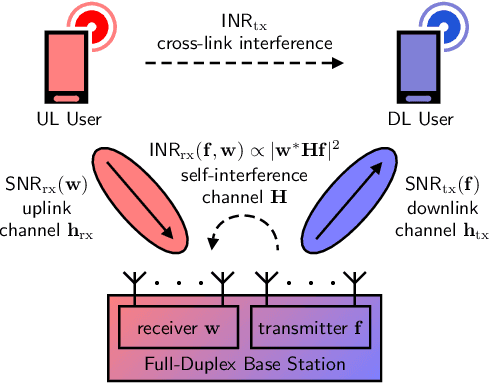
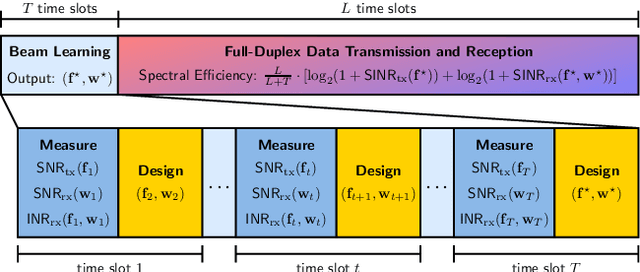

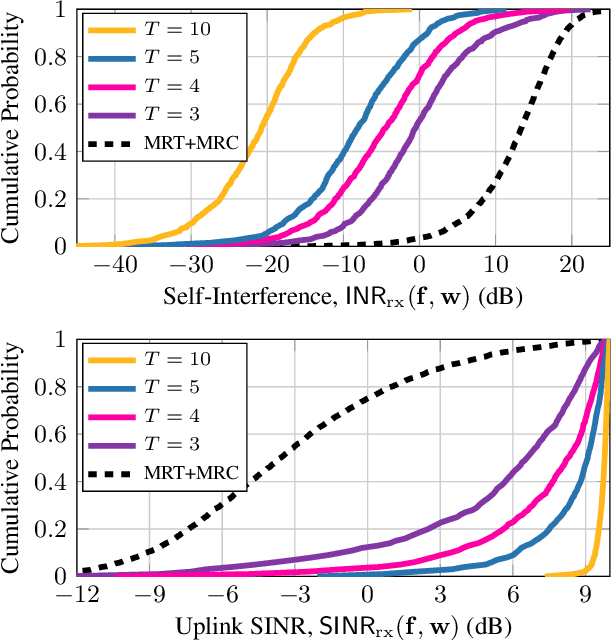
Abstract:In this paper, we present a novel active beam learning method for in-band full-duplex wireless systems, that aims to design transmit and receive beams which suppress self-interference and maximize the sum spectral efficiency. Rather than rely on explicit estimation of the downlink, uplink, and/or self-interference channels like in most existing work, our method instead actively probes all three channels through measurements of SNR and INR over a fixed number of time slots. Then, once this probing concludes, all collected probing measurements are used to design transmit and receive beams which serve downlink and uplink in a full-duplex fashion. We realize this active beam learning scheme through a network of LSTMs and DNNs, which learns to design each probing beam pair and subsequently extract and record valuable information from each probing measurement such that near-optimal serving beams can be designed following the probing stage. Simulation indicates that our method reliably suppresses self-interference while delivering near-maximal SNR on the downlink and uplink with merely 3-10 probing time slots, while exhibiting robustness to measurement noise and the structure of the self-interference channel.
Adaptive Cell Range Expansion in Multi-Band UAV Communication Networks
Nov 27, 2024Abstract:This paper leverages stochastic geometry to model, analyze, and optimize multi-band unmanned aerial vehicle (UAV) communication networks operating across low-frequency and millimeter-wave (mmWave) bands. We introduce a novel approach to modeling mmWave antenna gain in such networks, which allows us to better capture and account for interference in our analysis and optimization. We then propose a simple yet effective user-UAV association policy, which strategically biases users towards mmWave UAVs to take advantage of lower interference and wider bandwidths compared to low-frequency UAVs. Under this scheme, we analytically derive the corresponding association probability, coverage probability, and spectral efficiency. We conclude by assessing our proposed association policy through simulation and analysis, demonstrating its effectiveness based on coverage probability and per-user data rates, as well as the alignment between analytical and simulation results.
Analog Beamforming Codebooks for Wideband Full-Duplex Millimeter-Wave Systems
Nov 06, 2024

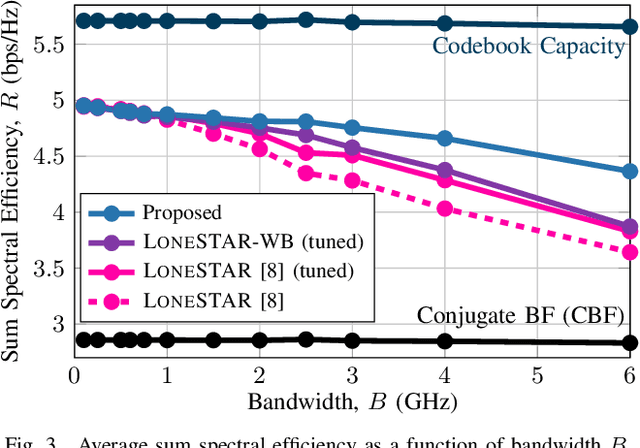
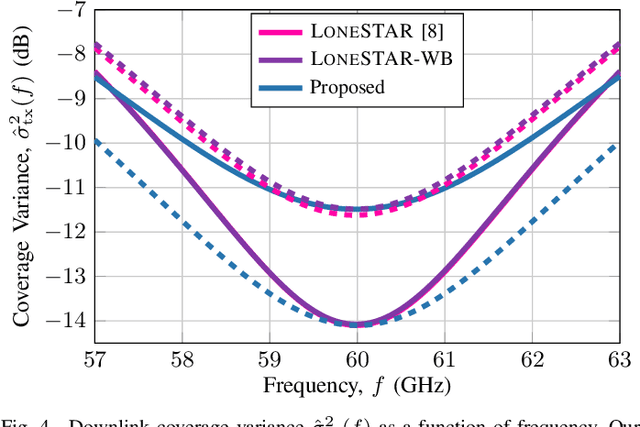
Abstract:In full-duplex millimeter-wave (mmWave) systems, the effects of beam squint and the frequency-selectivity of self-interference exacerbate over wide bandwidths. This complicates the use of beamforming to cancel self-interference when communicating over bandwidths on the order of gigahertz. In this work, we present the first analog beamforming codebooks tailored to wideband full-duplex mmWave systems, designed to both combat beam squint and cancel frequency-selective self-interference. Our proposed design constructs such codebooks by minimizing self-interference across the entire band of interest while constraining the coverage provided by these codebooks across that same band. Simulation results using computational electromagnetics to model self-interference suggest that a full-duplex 60 GHz system with our design enjoys lower self-interference and delivers better coverage across bandwidths as wide as 6 GHz, when compared to similar codebook designs that ignore beam squint and/or frequency-selectivity. This allows our design to sustain higher SINRs and spectral efficiencies across wide bandwidths, unlocking the potentials of wideband full-duplex mmWave systems.
Beam Tracking for Full-Duplex User Terminals in Low Earth Orbit Satellite Communication Systems
Nov 06, 2024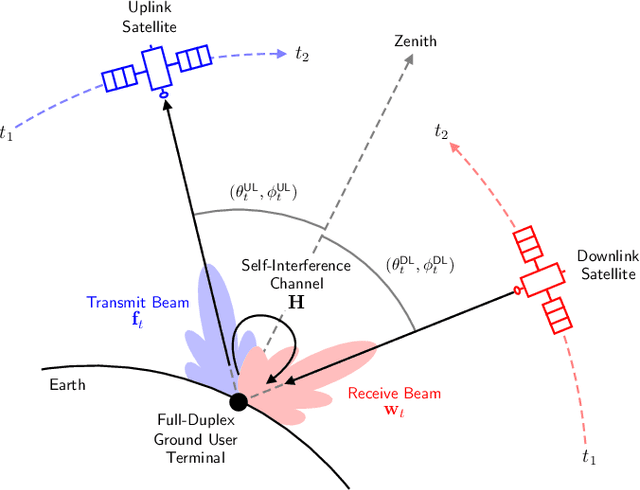
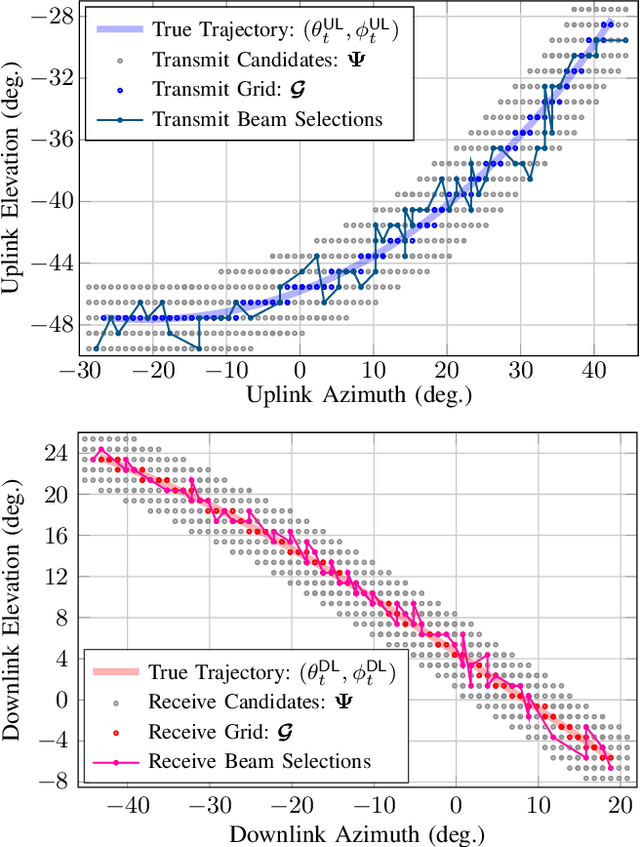
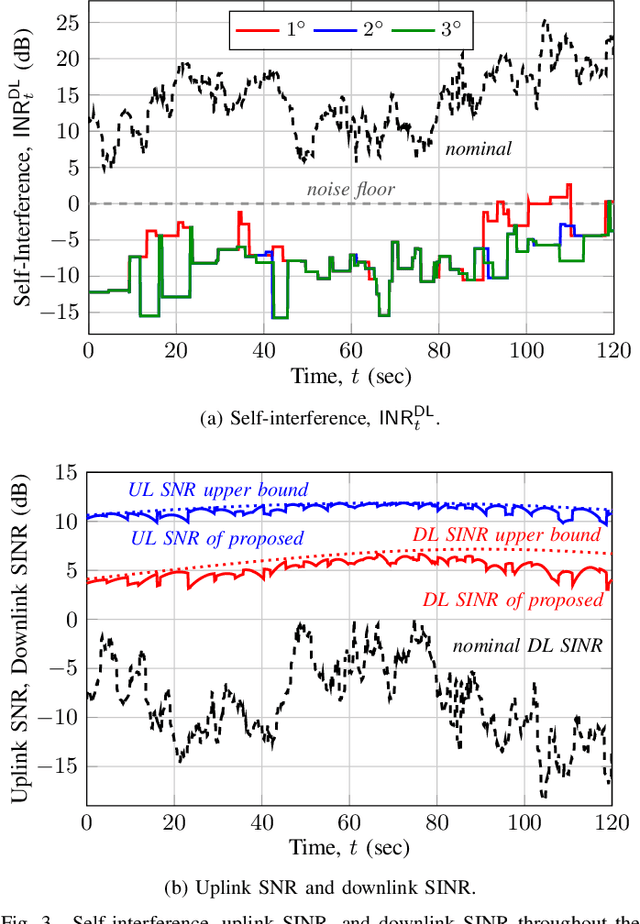
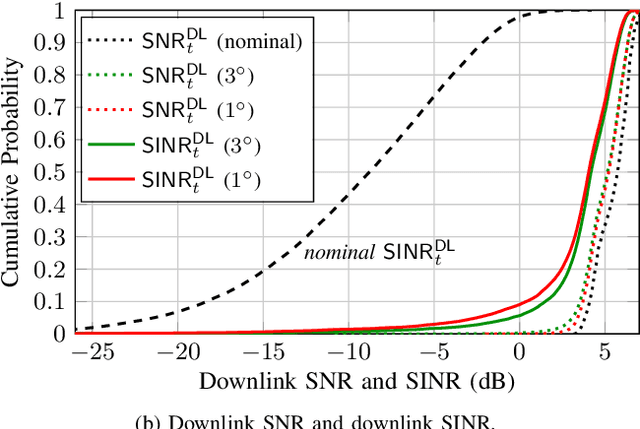
Abstract:This paper introduces a novel beam tracking scheme for full-duplex ground user terminals aiming to transmit uplink and receive downlink from two low Earth orbit (LEO) satellites at the same time and same frequency. Our proposed technique leverages observed phenomena from a recent measurement campaign to strategically select transmit and receive beams which couple low self-interference across the satellites' trajectories, thereby enabling in-band full-duplex operation. Our scheme takes a measurement-driven approach, meaning it does not rely on explicit knowledge of the self-interference channel and can inherently account for hardware impairments or other nonidealities. We show that our proposed scheme reliably selects beams which spatially cancel self-interference to below the noise floor, circumventing the need for digital/analog cancellation. Simulation results using satellite and orbital parameters published in 3GPP and FCC filings show that this substantial reduction in self-interference does not prohibitively compromise beamforming gain, allowing the user terminal to attain near-maximal SINRs, thus unlocking full-duplex operation.
A Survey on Advancements in THz Technology for 6G: Systems, Circuits, Antennas, and Experiments
Jul 02, 2024Abstract:Terahertz (THz) carrier frequencies (100 GHz to 10 THz) have been touted as a source for unprecedented wireless connectivity and high-precision sensing, courtesy of their wide bandwidth availability and small wavelengths, but noteworthy implementation challenges remain to make this a reality. In this paper, we survey recent advancements in THz technology and its role in future 6G wireless networks, with a particular emphasis on the 200-400 GHz frequency range and the IEEE 802.15.3d standard. We provide a comprehensive overview of THz systems, circuits, device technology, and antennas, while also highlighting recent experimental demonstrations of THz technology. Throughout the paper, we review the state-of-the-art and call attention to open problems, future prospects, and areas of further improvement to fully realize the potential of THz communication in next-generation wireless connectivity.
Nonlinear Self-Interference Cancellation With Learnable Orthonormal Polynomials for Full-Duplex Wireless Systems
Mar 17, 2024Abstract:Nonlinear self-interference cancellation (SIC) is essential for full-duplex communication systems, which can offer twice the spectral efficiency of traditional half-duplex systems. The challenge of nonlinear SIC is similar to the classic problem of system identification in adaptive filter theory, whose crux lies in identifying the optimal nonlinear basis functions for a nonlinear system. This becomes especially difficult when the system input has a non-stationary distribution. In this paper, we propose a novel algorithm for nonlinear digital SIC that adaptively constructs orthonormal polynomial basis functions according to the non-stationary moments of the transmit signal. By combining these basis functions with the least mean squares (LMS) algorithm, we introduce a new SIC technique, called as the adaptive orthonormal polynomial LMS (AOP-LMS) algorithm. To reduce computational complexity for practical systems, we augment our approach with a precomputed look-up table, which maps a given modulation and coding scheme to its corresponding basis functions. Numerical simulation indicates that our proposed method surpasses existing state-of-the-art SIC algorithms in terms of convergence speed and mean squared error when the transmit signal is non-stationary, such as with adaptive modulation and coding. Experimental evaluation with a wireless testbed confirms that our proposed approach outperforms existing digital SIC algorithms.
 Add to Chrome
Add to Chrome Add to Firefox
Add to Firefox Add to Edge
Add to Edge